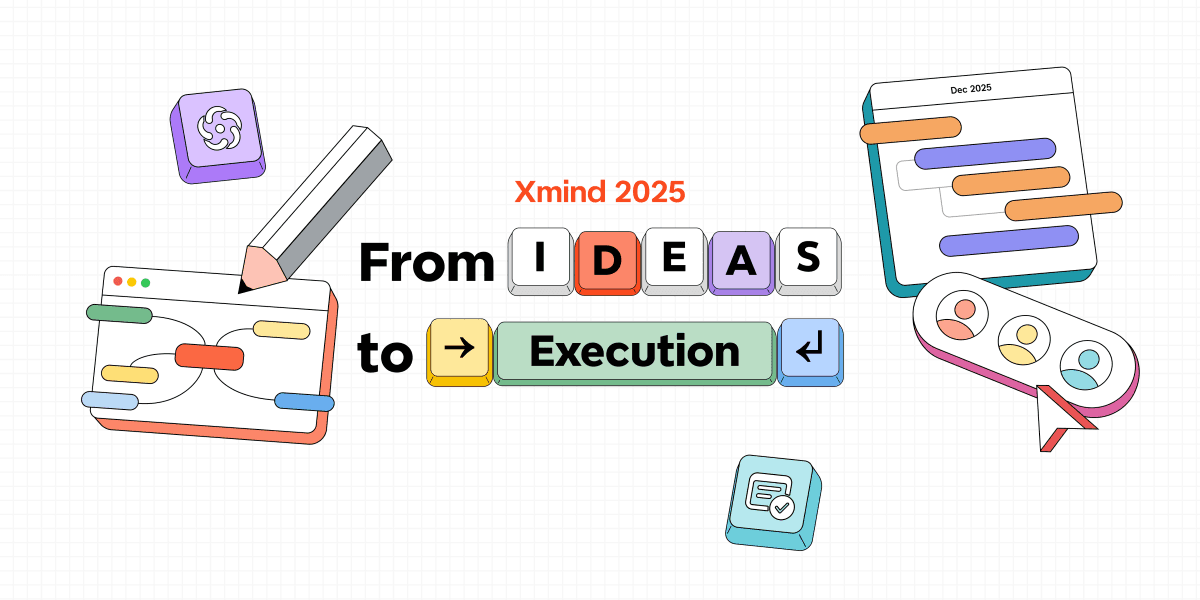Sep 22, 2025
Mastering SMART Goals: An In-Depth Guide to Effective Goal Setting

Hannah
Setting goals is an essential part of personal and professional growth. However, not all goals are created equal. To truly achieve what you set out to do, you need to establish goals that are clear, actionable, and time-sensitive. This is where the SMART framework comes into play. In this article, we will explore the concept of SMART goals, breaking down each component and providing practical examples to help you implement this powerful strategy in your own life.
To make the process even more effective, tools like Xmind can help you visualize your SMART goals, map out action steps, and track your progress. By turning abstract objectives into clear, structured mind maps, you can stay motivated and ensure that your goals remain both achievable and measurable.
Understanding SMART Goals
What is SMART goals definition
The SMART goals acronym stands for Specific, Measurable, Achievable, Relevant, and Time-bound. This framework is widely recognized for helping individuals and organizations create goals that are not only inspiring but also actionable. Each element ensures that goals are well-structured, realistic, and trackable, reducing ambiguity and boosting the likelihood of success.
By following the SMART goals definition, you transform vague aspirations into clear objectives. For example, “I want to improve my writing” becomes “I will write one blog article of 1,000 words every week for the next three months.” Such clarity ensures accountability and makes progress measurable.
Breaking down the SMART goals acronym
Specific: clarity is key
The first step is to eliminate vagueness. A goal should be crystal clear, answering the who, what, where, when, and why. When your objectives are specific, you create a roadmap that keeps you focused.
Example: Rather than saying, “I want to get fit,” a sharper goal would be, “I want to run a 5K race in my local park by the end of June.”
Guiding questions:
Try capturing these details with a SMART goals worksheet or visualizing them in a mind map to build clarity.
Measurable: track your progress
A goal only becomes powerful when you can measure it. By setting quantifiable criteria, you make progress visible and keep motivation high.
Example: Instead of saying, “I want to save more money,” commit to, “I want to save $5,000 by the end of the year.”
Guiding questions:
Using a SMART goals template helps you record numbers, percentages, or milestones to make tracking easier.
Achievable: set realistic goals
Ambition is important, but goals should also be within reach given your current resources and constraints. If a target is too unrealistic, it can quickly turn discouraging.
Example: Someone who currently runs one mile per week might aim for a 10K in six months rather than attempting a marathon in just a month.
Guiding Questions:
This way, goals remain challenging but still attainable.
Relevant: align with your values
Not every goal is worth pursuing. Relevance ensures that your efforts connect with your long-term vision and personal values.
Example: If your career path leads toward management, enrolling in a leadership training program is highly relevant, while learning an unrelated skill might not support that direction.
Guiding questions:
By checking for relevance, you ensure your energy is invested wisely.
Time-bound: set a deadline
Without a timeline, even the most specific goals can drift indefinitely. Deadlines add a sense of urgency and make accountability possible.
Example: Rather than saying, “I want to learn Spanish,” make it, “I want to be conversational in Spanish within six months.”
Guiding questions:
Breaking big goals into smaller time-based milestones keeps you moving forward step by step.
The Importance of SMART Goals
Understanding the importance of SMART goals is just as crucial as knowing the framework itself. While the acronym explains how to set goals, this section highlights why using SMART goals makes such a difference in both personal and professional contexts.
Clarity: a clear path forward
SMART goals eliminate ambiguity. Instead of vague aspirations like “I want to do better at work,” you define exactly what success looks like. Clear objectives help you prioritize, allocate resources effectively, and avoid wasted effort. With a SMART goals worksheet, you can map out each detail, ensuring that every step aligns with your broader vision.
Motivation: progress you can see
When goals are measurable, you can track progress and celebrate small wins along the way. Hitting milestones — whether saving the first $1,000 toward a financial goal or completing the first module of an online course — boosts confidence and sustains momentum. This sense of progress keeps you engaged even when challenges arise.
Accountability: staying on track
Deadlines and measurable outcomes create a sense of accountability. Whether you’re working individually or in a team, SMART goals make it clear what needs to be achieved and by when. This accountability not only drives personal discipline but also fosters team alignment, since everyone can see where efforts are focused and how success will be measured.
Flexibility: adaptable to change
Life and business rarely go exactly as planned. One of the strengths of the SMART framework is its adaptability. If circumstances shift, you can revisit your goals — adjusting timelines, refining scope, or re-evaluating relevance — without abandoning the overall vision. This makes SMART goals practical for dynamic environments such as project management, career development, or personal growth.
Alignment: connecting short-term actions with long-term vision
Beyond immediate outcomes, SMART goals ensure that short-term efforts are meaningful in the bigger picture. They link day-to-day actions with broader objectives, helping you stay consistent with your core values and long-term ambitions. For example, a short-term SMART goal of completing a certification course directly supports a long-term career vision of becoming a leader in your field.
How to Craft Your SMART Goals
Now that we understand the components of SMART goals, it’s time to put them into practice. Crafting effective goals is about more than just writing down what you want — it requires structure, clarity, and follow-through. Here’s how you can do it step by step.
Step 1: identify your objective
Every great goal starts with a clear vision. Think about what area of your life you want to improve — career, health, education, or personal growth. Don’t worry about perfection here; the key is to capture your big-picture ambition. For example, you might begin with something broad like: “I want to improve my physical fitness.”
Unlike later steps, this stage is less about detail and more about direction-setting.
Step 2: apply the SMART criteria
Now refine your initial idea by running it through the SMART framework. Instead of a long explanation, here’s a quick checklist you can use:
Specific — What exactly do I want?
Measurable — How will I track success?
Achievable — Is this realistic with my current resources?
Relevant — Does it align with my bigger picture?
Time-bound — When do I want to achieve it?
Case in point: “I want to get fit” → “I will complete a 5K run in three months.”
Using a SMART goals template here helps you avoid skipping any element of the acronym.
Step 3: write it down
Instead of just another explanation, let’s look at some contrasting scenarios:
Someone keeps a vague goal in their head: “I want to save more money.” → This often fades away.
Someone writes: “I will save $5,000 by December 31.” → This becomes a visible, actionable commitment.
Research shows people are far more likely to succeed when goals are written down. Try using a SMART goals worksheet or a visual tool like Xmind — you’ll not only capture the goal but also create a reference you can return to.
Step 4: create an action plan
Here we shift gears into task breakdown. A SMART goal is only powerful if supported by actionable steps.
Mini-example:
Goal: Save $5,000 in 12 months.
Action plan: Save 420 monthly → Break down into 105 weekly → Automate transfers every Friday.
Or, if your goal is career-based, your plan might look like:
Enroll in an online certification course.
Complete one module per week.
Schedule monthly practice sessions or networking calls.
This step works best in a visual format — mind maps, flowcharts, or even sticky notes. The more tangible your plan, the easier it is to stay committed.
Step 5: monitor your progress
Finally, goals require ongoing reflection. Here, instead of a narrative, let’s use questions as prompts:
Am I on track with my timeline?
What milestones have I reached so far?
Do I need to adjust resources or expectations?
What lessons have I learned that can refine my next goal?
This review process keeps you agile. Even if you fall behind, the act of checking in gives you a chance to recalibrate rather than abandon your goal altogether.
Examples of SMART Goals
To illustrate how to create SMART goals, let’s look at a few practical examples across different areas of life. These scenarios show how broad aspirations can be transformed into clear, actionable targets using the SMART framework.
Example 1: career development
Imagine you’re aiming to advance in your career. Instead of vaguely saying “I want to do better at work,” you can create a SMART goal around a promotion:
Specific: Earn a promotion to Senior Analyst.
Measurable: Track progress by completing three professional development courses and seeking regular feedback from your manager.
Achievable: Balance the training workload alongside current responsibilities, dedicating two evenings a week to coursework.
Relevant: The promotion supports your long-term ambition of becoming a department manager.
Time-bound: Target the promotion within the next 12 months.
By combining professional development with measurable milestones, this goal creates a structured pathway toward career advancement.

Example 2: health and fitness
Many people set health-related goals, but without structure, they can easily lose momentum. A SMART goal makes the journey concrete:
Instead of “I want to get healthier,” you might decide: “I want to lose 15 pounds.” To make it SMART:
You will track progress weekly, logging weight and daily food intake.
A realistic plan includes exercising three times per week (e.g., cardio and strength training) and following a balanced diet.
The relevance is clear—losing weight boosts energy levels and overall well-being.
With a defined timeline of three months, you create urgency and accountability.
This clarity transforms a general wish into a sustainable fitness strategy.
Example 3: financial goals
Saving money is a common aspiration, but the SMART approach makes it specific and achievable. Instead of simply saying “I want to save more,” consider this:
Objective: Save $10,000 for a family vacation.
Plan: Contribute $500 each month into a dedicated savings account.
Achievability: Make adjustments such as reducing dining out and limiting entertainment expenses.
Relevance: The goal matters because the vacation represents valuable time for rest and family bonding.
Deadline: Reach the $10,000 target by year-end.
Breaking the financial goal into monthly savings milestones makes it realistic and motivating.
Example 4: education and learning
SMART goals also work well in academic or skill-building contexts. For instance:
A student might decide to “improve English writing skills by completing one essay every week and enrolling in a writing workshop.”
The goal is measurable through the number of essays written and feedback from instructors.
It’s achievable with regular practice, relevant to the student’s academic success, and time-bound by setting a three-month period for improvement.
This structured approach ensures steady growth and measurable progress in learning.
Utilizing Tools for SMART Goals Setting
In today’s fast-paced world, digital tools have become indispensable for effective goal setting. While pen and paper can capture ideas, they often fall short when it comes to maintaining clarity, tracking progress, and adapting to change. This is where Xmind comes in. As a professional mind mapping software, Xmind transforms your SMART goals into structured, visual plans that are easier to organize, monitor, and adjust over time.
Visualizing SMART goals clearly
When goals stay abstract, teams often lose direction. Xmind turns those abstract intentions into structured, visual frameworks. By placing your primary objective at the center and branching into tasks, deadlines, and milestones, you can see both the high-level vision and the details that support it. Different chart views such as Tree Chart, Logic Chart, or Timeline make it easy to choose the right perspective depending on whether you’re mapping dependencies, sequencing tasks, or highlighting progress.
Summary: group related items under one theme for clarity.
Color themes and styles: emphasize priorities or categories at a glance.
This approach ensures clarity and reduces the chance of overlooking critical steps.
Tracking and reviewing progress
Instead of relying on scattered to-do lists, Xmind keeps your progress inside the same visual map. With its Task, you can assign check boxes, update completion status, and instantly see overall progress reflected in parent branches. This transforms your SMART goals into a “live document” that evolves as you work through them.
Markers can be layered directly onto branches, turning your map into both a plan and a monitoring tool. Unlike static spreadsheets, this method combines structure with adaptability, helping you stay accountable without losing flexibility.
Enhancing collaboration and accountability
For team-oriented SMART goals, collaboration is essential. Xmind’s Real-time Collaboration enables multiple contributors to update the same mind map simultaneously. Instead of passing documents back and forth, everyone sees the latest version and can add feedback directly to the map.
Cross-platform sync keeps updates aligned across desktop, web, and mobile.
Comments and permissions make it easy to control who edits, views, or provides input.
This interactive workflow builds accountability, making responsibilities visible to everyone involved.
Adapting to change with flexibility
Projects evolve, and goals often shift midstream. With Xmind, you don’t need to rebuild your entire plan when things change — you simply drag and rearrange branches to reflect new priorities. You can also switch to Matrix view when comparing tasks across categories, or Timeline view when schedules become the primary focus.
By combining markers, labels and other functions, you can highlight risks, dependencies, or urgent items without rewriting your map. This adaptability ensures that your SMART goals remain practical and relevant, even in rapidly changing environments.
Conclusion
Setting SMART goals is a powerful strategy for achieving personal and professional success. By following the SMART framework, you can create clear, actionable objectives that guide your efforts and keep you motivated. Remember to utilize tools like Xmind to enhance your goal-setting process and stay organized. Start your journey towards success today by defining your SMART goals and taking actionable steps to achieve them.
By mastering the art of SMART goal setting, you can transform your aspirations into reality and pave the way for a fulfilling and successful future.
FAQs
What are some common mistakes when setting SMART goals?
One of the most frequent mistakes is making goals too broad or unrealistic, which undermines the “Specific” and “Achievable” aspects of the SMART framework. Another pitfall is failing to set measurable criteria — if you can’t track progress, it’s easy to lose motivation. Some people also forget to set deadlines, leaving goals open-ended. Using a SMART goals worksheet can help avoid these errors by prompting you to consider each element systematically.
How can SMART goals be applied in teamwork or business settings?
SMART goals are not just for personal growth — they’re highly effective in team environments. For example, instead of a vague team objective like “improve sales,” a team could adopt a SMART goal: “Increase sales revenue by 15% in Q3 by launching two new client outreach campaigns.” In such contexts, a SMART goals template ensures consistency across departments, aligning everyone with clear and measurable outcomes.
Are SMART goals flexible enough for long-term projects?
Yes. While SMART goals emphasize deadlines and measurability, they can absolutely be adapted for long-term projects. The key is to break down a larger vision into smaller, time-bound steps, revisiting and revising them as needed. For instance, a five-year career goal can be divided into yearly SMART goals with specific milestones. This flexibility makes the framework practical for both short-term wins and long-term strategies.
How do SMART goals compare to traditional goal setting?
Traditional goals often lack structure, which can make them harder to achieve. For instance, “I want to learn a new skill” doesn’t provide a clear plan or timeline. In contrast, SMART goals bring focus and accountability by demanding specificity, measurement, and deadlines. Real SMART goals examples — like “I will complete an online coding course with weekly assignments and finish by December 1” — illustrate how much more actionable this framework is compared to general goal-setting.
What tools can support SMART goal tracking?
Beyond pen and paper, digital tools enhance the effectiveness of SMART goals. A SMART goals worksheet provides a structured space to define and review goals, while a template ensures nothing is overlooked when setting them. Tools like Xmind go further by enabling visualization — turning goals into interactive mind maps where tasks, timelines, and milestones are interconnected. This makes tracking progress engaging and easy to adapt when circumstances change.











